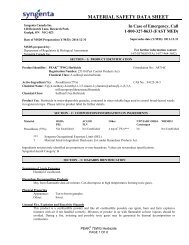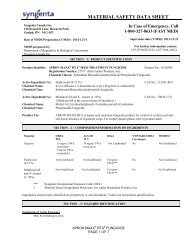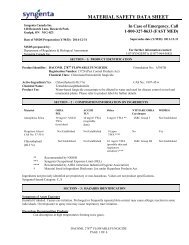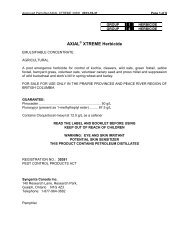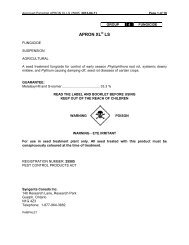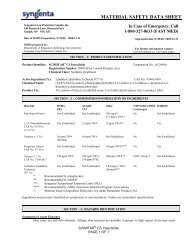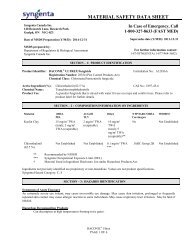Bonzi MSDS - Syngenta Crop Protection
Bonzi MSDS - Syngenta Crop Protection
Bonzi MSDS - Syngenta Crop Protection
- No tags were found...
You also want an ePaper? Increase the reach of your titles
YUMPU automatically turns print PDFs into web optimized ePapers that Google loves.
Freezing point: Not Applicable.Specific gravity or density: 0.61 g/cm³.Evaporation Rate: Not available.Water/oil partition coefficient: Not available.Odour threshold: Not available.Viscosity: Not Applicable.Solubility in Water: 7.7 mg/L @ 20 o C (Acibenzolar-S-Methyl Technical).SECTION – 10: STABILITY AND REACTIVITYChemical stability: Stable under normal use and storage conditions.Conditions to avoid: None known.Incompatibility with other materials: None known.Hazardous decomposition products: During a fire, irritating and possibly toxic gases may be generated by thermaldecomposition or combustion.Hazardous polymerization: Will not occur.SECTION – 11: TOXICOLOGICAL INFORMATIONAcute toxicity/Irritation Studies (Finished Product):Ingestion:Low AcuteToxicityOral (LD50 Rabbit):> 5,000 mg/kg body weightDermal:Inhalation:Eye Contact:Skin Contact:Skin Sensitization:Low AcuteToxicityDermal (LD50 Rat):Low AcuteToxicityInhalation (LC50 Rat):Slightly Irritating (Rabbit)Mildly Irritating (Rabbit)Not a Sensitizer (Guinea Pig)> 2,000 mg/kg body weight> 2.79 mg/L air - 4 hoursReproductive/Developmental EffectsAcibenzolar-S-Methyl Technical:Developmental toxicity and fetal malformations at high maternal doses (rats).Chronic/Subchronic Toxicity StudiesAcibenzolar-S-Methyl Technical:Slight hemolytic anemia at highest dose level (rats, mice and dogs). Liver and spleen effectsobserved in highest dose level (rats and dogs).CarcinogenicityAcibenzolar-S-Methyl Technical:Not carcinogenic at dietary levels up to 7500 ppm (rat) and 6000 ppm (mouse).Other Toxicity Information:None.Toxicity of Other ComponentsDiatomaceous EarthThe carrier in this product is naturally occurring diatomaceous earth. Natural diatomaceous earth containsa small percentage of naturally occurring crystalline silica, which is considered a probable humancarcinogen. Chronic inhalation exposure to crystalline silica is known to cause silicosis and pulmonaryACTIGARD ® 50WGPAGE 4 OF 6


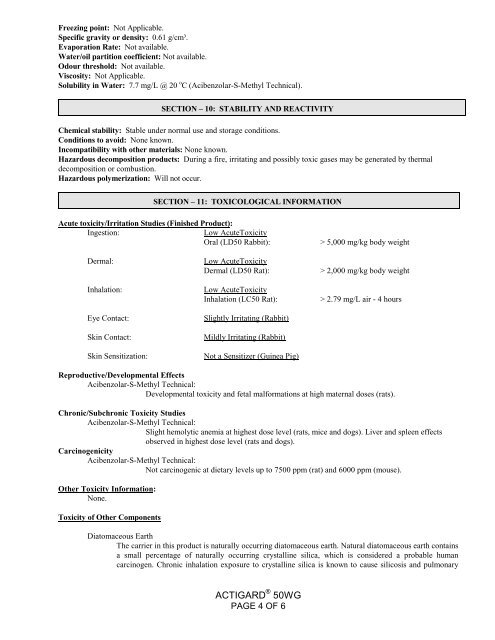
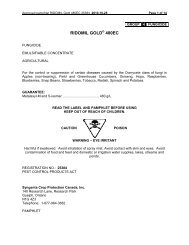
![gesagard 480sc [pamphlet] - Syngenta Crop Protection](https://img.yumpu.com/50945984/1/190x245/gesagard-480sc-pamphlet-syngenta-crop-protection.jpg?quality=85)
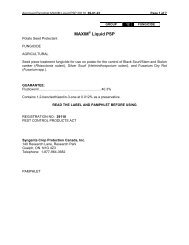
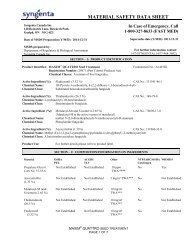
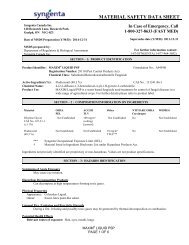
![ridomil Gold mz 68wp [bag] - Syngenta Farm](https://img.yumpu.com/49025229/1/190x245/ridomil-gold-mz-68wp-bag-syngenta-farm.jpg?quality=85)
